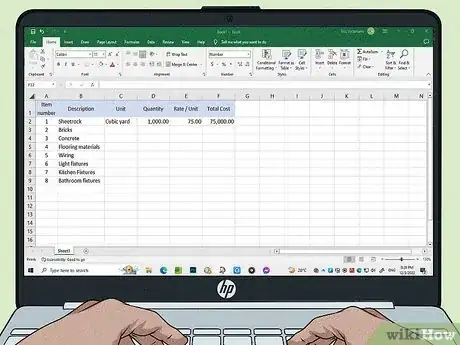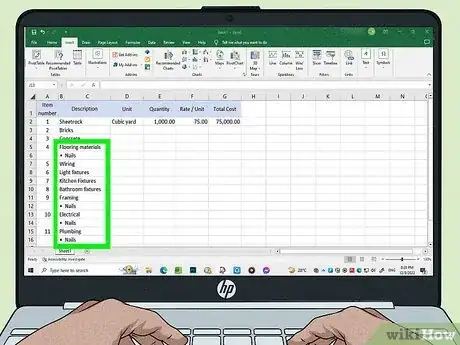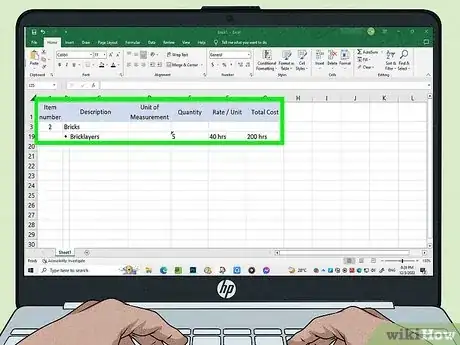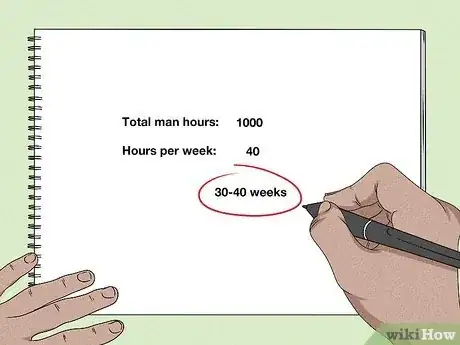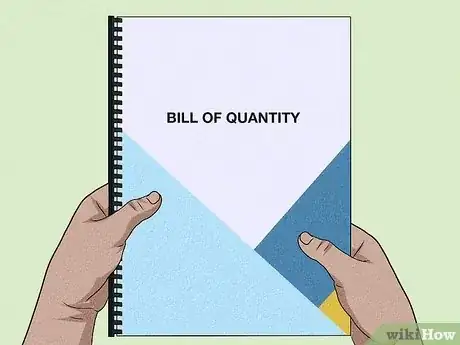This article was co-authored by Jennifer Mueller, JD. Jennifer Mueller is an in-house legal expert at wikiHow. Jennifer reviews, fact-checks, and evaluates wikiHow's legal content to ensure thoroughness and accuracy. She received her JD from Indiana University Maurer School of Law in 2006.
There are 8 references cited in this article, which can be found at the bottom of the page.
This article has been viewed 185,963 times.
Planning a construction project? You might need a bill of quantities (BOQ). A BOQ itemizes the specific materials and labor needed for the project so you can get accurate bids from contractors. In the field, BOQs are typically prepared by quantity surveyors or civil engineers who specialize in them. But even if you don't regularly prepare BOQs, it's worth knowing how they're made so you can evaluate the quality of the ones you see. Read on to learn everything you need to know about how to prepare an organized and reliable BOQ, as well as how to put this document to work for you during the planning and construction process.
Things You Should Know
- Use a BOQ to specify all of the materials you'll need for a project.
- Make a simple spreadsheet to easily organize your BOQ.
- Choose the best contractors for your project based on their BOQ cost estimates.
- Continue using your BOQ throughout your project for scheduling and cost planning.
Steps
Community Q&A
-
QuestionHow much does a quantity surveyor charge per hour?
 wikiHow Staff EditorThis answer was written by one of our trained team of researchers who validated it for accuracy and comprehensiveness.
wikiHow Staff EditorThis answer was written by one of our trained team of researchers who validated it for accuracy and comprehensiveness.
Staff Answer wikiHow Staff EditorStaff AnswerQuantity surveyor rates vary significantly based on their experience and where they're located, but you can generally expect to spend about 2% of the total project value.
wikiHow Staff EditorStaff AnswerQuantity surveyor rates vary significantly based on their experience and where they're located, but you can generally expect to spend about 2% of the total project value. -
QuestionHow does taking off relate to preparing a Bill of Quantities? How do you take off quantities from a floor plan and use the data to prepare a bill of quantity?
 wikiHow Staff EditorThis answer was written by one of our trained team of researchers who validated it for accuracy and comprehensiveness.
wikiHow Staff EditorThis answer was written by one of our trained team of researchers who validated it for accuracy and comprehensiveness.
Staff Answer wikiHow Staff EditorStaff Answer"Taking off" is the process of using the data on an architect's plan to create your BOQ. The plan will list the specifications for each material used—you simply copy that information into your BOQ, with one row for each material. If you've divided your project into multiple parts, you might have materials that are used in more than one part. In that case, you'd need to determine how much of each material you needed for each part and enter those quantities in separate rows for each part.
wikiHow Staff EditorStaff Answer"Taking off" is the process of using the data on an architect's plan to create your BOQ. The plan will list the specifications for each material used—you simply copy that information into your BOQ, with one row for each material. If you've divided your project into multiple parts, you might have materials that are used in more than one part. In that case, you'd need to determine how much of each material you needed for each part and enter those quantities in separate rows for each part.
Warnings
- Don't get a bill of quantities (BOQ) confused with a bill of materials (BOM). While they both list quantities of specific materials needed to complete a project, a BOQ is used in construction and includes labor estimates. A BOM, on the other hand, is more typically used in manufacturing and doesn't include labor.[12]⧼thumbs_response⧽
References
- ↑ http://people.tamu.edu/~i-choudhury/boq.htm
- ↑ http://people.tamu.edu/~i-choudhury/boq.htm
- ↑ http://kmidraughting.co.za/pdf/Bills_of_Quantities.pdf
- ↑ http://people.tamu.edu/~i-choudhury/boq.htm
- ↑ https://www.cmu.edu/cee/projects/PMbook/04_Labor,_Material,_And_Equipment_Utilization.html
- ↑ https://www.cmu.edu/cee/projects/PMbook/05_Cost_Estimation.html
- ↑ http://people.tamu.edu/~i-choudhury/boq.htm
- ↑ https://lni.wa.gov/licensing-permits/contractors/hiring-a-contractor/
- ↑ https://lni.wa.gov/licensing-permits/contractors/hiring-a-contractor/
About This Article
A Bill of Quantities is a list of the total materials required to complete a construction project. You’ll need this to get an accurate quote for your construction project. Create a spreadsheet for your bill of quantities with columns for the item numbers, descriptions, units of measurement, quantities, rates for each item, labor, and total cost. Add 15 to 20 percent to the cost of materials to account for waste. Then, separate your items into categories like flooring, plumbing, and electrical. You’ll also need to include labor for each category in man-hours. Ask a contractor for an estimate, then factor in an extra 30 to 40 percent for things like bad weather and materials not arriving on time. For more tips, including how to hire a quantity surveyor, read on!

